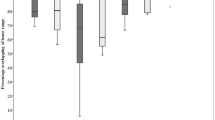Abstract
We describe diurnal habitat used by red deer (Cervus elaphus L.) in two representative forests of Haute Ardenne. We captured 17 calves and 13 adults and fitted them with VHF transmitters (ear tags or collars). Each animal was radio-tracked at least once per week during the daylight hours and relocated by triangulation. To determine habitat use, we used compositional analysis. We defined use for each animal as the proportion of relocations in each vegetation association. Each relocation was weighed according to its accuracy (i.e., based on the confidence ellipse computation). We defined availability as the proportion in the area of each vegetation association within its home range (i.e., minimum convex polygon). Red deer calves preferred edges in open areas (e.g., clear-cuts) during their first 3 months of life. Adults used open coniferous [e.g., natural regeneration of spruce (Picea abies)] stands and edges between coniferous stands and other vegetation associations. Closed coniferous stands were preferred during winter and deer usually used the edges of habitat patches rather than the core areas, except in winter for coniferous stands. The deciduous stands [e.g., old growth stands of beech (Fagus sylvatica)] were usually avoided, except in winter when the edges of deciduous stands were used. The availability of coniferous stands and edges partly determined the size of the diurnal home ranges.



Similar content being viewed by others
References
Aebischer NJ, Robertson PA, Kenward RE (1993) Compositional analysis of habitat use from animal radio-tracking data. Ecology 74:1313–1325
Birtles T, Goldspink CR, Gibson S, Holland RK (1998) Calf site selection by red deer (Cervus elaphus) from three contrasting habitats in Nort-West England: implications for welfare and management. Anim Welf 7:427–443
Boyle SA, Samson FB (1985) Effects of non-consumptive recreation on wildlife: a review. Wildl Soc Bull 13:110–116
Georgii B (1980) Home range patterns of female red deer (Cervus elaphus L.) in the Alps. Oecologia 47:278–285
Hamann JL, Klein F, Saint-Andrieux C (1997) Domaine vital diurne et déplacements de biches (Cervus elaphus) sur le secteur de La Petite Pierre (Bas-Rhin). Game Wildl Sci 14:1–17
Hooge PN, Eichenlaub B (1997) Animal movement extension to ArcView. ver. 1.1. Alaska Science Center–Biological Science Office, U.S. Geological Survey, Anchorage, AK, USA
Jeppesen JL (1987) Impact of human disturbance on home range, movements and activity of red deer in a Danish environment. Dan Rev Game Biol 13:1–33
Johnson DH (1980) The comparison of usage and availability measurements for evaluating resource preference. Ecology 61:65–71
Leban FA (1999) Performance of five resource selection methods under different sampling designs: a case study with elk radio-telemetry data. Ph.D. thesis, University of Idaho
Lenth RV (1981) Robust measures of location for directional data. Technometrics 23:77–81
Licoppe AM, Prevot C, Verheyden H (2005) Measuring the impact of human disturbance on free ranging red deer (Cervus elaphus L.) by telemetry. In: Pohlmeyer K (ed) Extended abstracts of the XXVIIth Congress of the International Union of Game Biologists, Hannover 2005. DSV-Verl., Hamburg, p 393
Mysterud A, Ostbye E (1999) Cover as a habitat element for temperate ungulates: effects on habitat selection and demography. Wildl Soc Bull 27:385–394
Richard A, Picars A (1996) Mise au point d’une technique de capture de faons de cerf élaphe. Bull Mens Off Natl Chasse 209:2–9
Staines BW (1974) A review of factors affecting deer dispersion and their relevance to management. Mamm Rev 4:79–91
Szemethy L, Heltai M, Matrai K, Peto Z (1998) Home ranges and habitat selection of red deer (Cervus elaphus) on a lowland area. In: Havet P et al (eds) Proceedings of the XXIIIrd Congress of the International Union of Game Biologists (IUGB), Lyon, France, 1–6 September 1997. Gibier Faune Sauvage 15:607–615
White GC, Garrott RA (1990) Analysis of wildlife radiotracking data. Academic, San Diego
Acknowledgements
Red deer were captured in accordance with the regional law: Arrêté du Gouvernement wallon (du 7 mars 2001) autorisant le Laboratoire de la Faune sauvage et de Cynégétique du Centre de Recherche de la Nature, des Forêts et du Bois à immobiliser temporairement des animaux des espèces Cerf et Sanglier dans certains territoires de chasse à des fins de recherches scientifiques (Moniteur Belge 11.05.2001). The study was financially supported by the Walloon Region (MRW-DGRNE). Most of the field data were collected by Julien Lievens (Centre de Recherche de la Nature, des Forêts et du Bois) and some rangers of the Royal Hunts (Division de la Nature et des Forêts). Scientific support was provided by Simon de Crombrugghe (CRNFB), Professors Eric Leboulengé and Pierre Dedourny (Université catholique de Louvain), and Doctor Georges Janeau (Institut national de Recherches agronomiques–Comportement et Ecologie de la Faune sauvage). The comments of Jim Casaer (Instituut voor Bosbouw en Wildbeheer) and Isabelle Noirot greatly improved the manuscript, as well as the comments of two anonymous reviewers of the European Journal of Wildlife Research.
Author information
Authors and Affiliations
Corresponding author
Rights and permissions
About this article
Cite this article
Licoppe, A.M. The diurnal habitat used by red deer (Cervus elaphus L.) in the Haute Ardenne. Eur J Wildl Res 52, 164–170 (2006). https://doi.org/10.1007/s10344-006-0027-5
Received:
Accepted:
Published:
Issue Date:
DOI: https://doi.org/10.1007/s10344-006-0027-5




